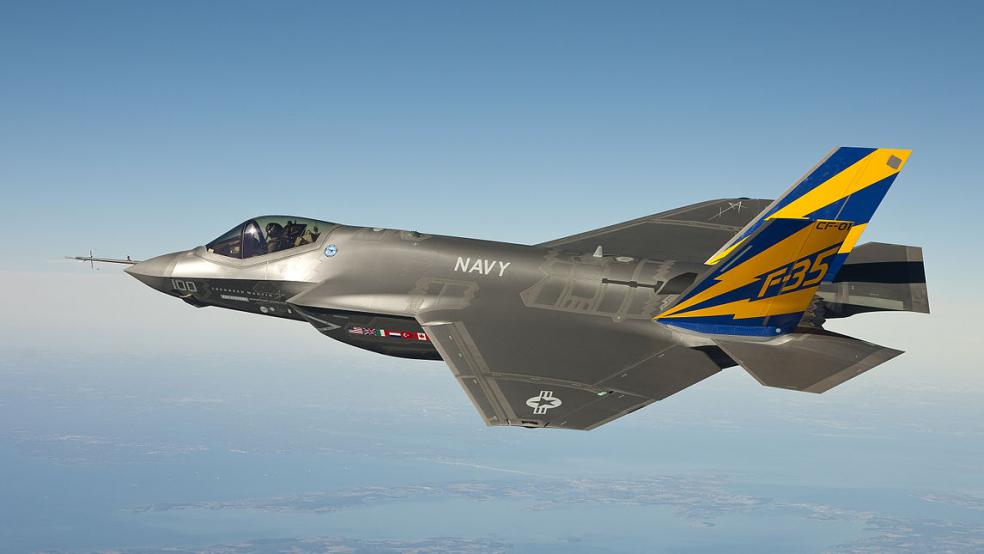The Pentagon’s golden bird – the F-35 Joint Strike Fighter – may be the most controversial U.S. weapons system ever built, partly because of the estimated $1 trillion price tag over the decades-long life of the program, partly because the list of flaws never seems to end.
The latest glitch is a life-threatening one.
Related: Why the F-35 May Not Be Combat-Ready Until 2022
Some 55 F-35As at Luke Air Force Base in Arizona were indefinitely grounded this week because of five incidents of pilots suffering from oxygen deprivation.
Hypoxia, as the condition is called, has long been a problem for military aircraft. In late March, Bloomberg reported that incidents of hypoxia among pilots of F/A-18 Hornets and Super Hornets have been escalating for a year.
It quoted from a memo prepared for Navy officials testifying before a House Armed Services subcommittee that said: “Since May 1, 2010, all models [of the F-18] show steady, yearly increases in the number of physiological episodes.”
On Tuesday, the Marine Times reported that the Navy still has not figured out what is causing oxygen deprivation problems not only with the F/A-18s but also with T-45 training jets.
Related: F-18 vs. F-35: Why Is Trump Talking Up the Super Hornet?
In April, T-45s were grounded after dozens of Navy instructors refused to fly them.
Vice Adm. Paul A. Grosklags, the commander of Naval Air Systems, told a Senate Armed Services subcommittee on Tuesday: ““We’re not doing well on the diagnosis. To date, we have been unable to find any smoking gun.”
He said the issue with the T-45 involves toxic gas, while with F-18s it is cockpit pressurization, the Marine Times said.
An Air Force spokesman said the cause of the oxygen incidents at Luke Air Force Base remain unknown, but there have been no similar episodes reported at other bases with F-35s since May 2. And the Marines have had no incidents of hypoxia with their F-35Bs.
Related: A Fleet of ‘Lightning Carriers’: The Marines’ Big Plans for the F-35
But episodes of oxygen deprivation, which can cause a pilot to become dizzy, disoriented or lose consciousness, are just the latest in a laundry list of serious problems plaguing the F-35. Among other recent issues are:
- Ejection. Until it announced last month that it had fixed the problem, the Air Force was restricting pilots weighing less than 136 pounds from flying its F-35As. Tests had shown that there was a 23 percent chance of lighter-weight pilots being killed and a 100 percent chance of being injured if forced to eject from the stealth jets. Modifications were made to helmets and ejection seats, and more svelte pilots will be allowed in the cockpit starting in 2018.
- Nose Gear. Pilots flying the F-35C reported that the aircraft nose gear would bob up and down so violently when the aircraft was launched from a carrier catapult that they couldn’t read the instrument panel and would even experience pain. Defense News reported in March that Lockheed is working on a fix.
- Insulation. Last fall the Air Force grounded 13 of its F-35As because of crumbling cooling insulation in the wing fuel tanks of the fighter. A pair of Norwegian F-35As were also down for repairs with the same problem, which aircraft manufacturer Lockheed Martin attributed to faulty materials from one of its subcontractors. The degraded insulation could have led to structural damage to the fuel tanks, an Air Force spokesperson said.
Still, the F-35 is finding buyers around the world. Despite the internecine battle between the Gulf States pitting Saudi Arabia and its allies against Qatar – a diplomatic wrangle that President Trump at one point tweeted his way into -- the U.S. yesterday moved ahead with plans to sell F-35s to Doha in a deal worth $12 billion.





